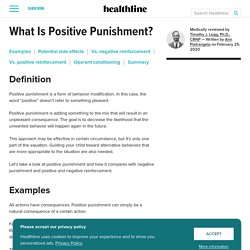

In reinforcements, there are positive and negative reinforcements. Similarly, there are also positive and negative punishments. The principles of reinforcement and punishment will be explained in greater detail below.
We will also explore how the concepts of reinforcements and punishments can be used to influence the behavior of teenagers. As teenagers are more developed holistically in comparison to kids and toddlers, parents should adopt the concept of reinforcements and punishments carefully in order to achieve the desired outcome.
Operant Conditioning: Explained!
Skinner’s Operant Conditioning: Rewards & Punishments. Reinforcement and Punishment: Explained!
Summarized: Reinforcement and Punishment Chart.
Reinforcement vs Punishment Psychology [Examples] Reinforcement and punishment are often used as parenting tools to modify children’s behavior.
![Reinforcement vs Punishment Psychology [Examples]](http://cdn.pearltrees.com/s/pic/th/reinforcement-punishment-183049524)
Let’s review the difference between positive reinforcement and negative reinforcement, and the difference in outcomes between them. The Difference Between Positive And Negative Reinforcement In behavioral psychology, reinforcement is the introduction of a favorable condition that will make the desired behavior more likely to happen, continue or strengthen in the future1. Parenting: Using Principles of Reinforcements and Punishments. Positive Reinforcement in Teenage Children. Positive Reinforcement - Tips for teaching and parenting. Negative Reinforcement in Teenage Children. Negative Reinforcement: What Is It and How Does It Work? What is negative reinforcement?

Negative reinforcement is a method that can be used to help teach specific behaviors. With negative reinforcement, something uncomfortable or otherwise unpleasant is taken away in response to a stimulus. Positive Punishment in Teenage Children. Positive Punishment: What It Is, Benefits, and Examples. Positive punishment is a form of behavior modification.

In this case, the word “positive” doesn’t refer to something pleasant. Positive punishment is adding something to the mix that will result in an unpleasant consequence. The goal is to decrease the likelihood that the unwanted behavior will happen again in the future. This approach may be effective in certain circumstance, but it’s only one part of the equation. Guiding your child toward alternative behaviors that are more appropriate to the situation are also needed. Negative Punishment in Teenage Children. What is Negative Punishment (Examples and Effectiveness) In this article, we will review negative punishment, its definition, examples, and drawbacks.

American psychologist B.F. Skinner developed the theory of operant conditioning, which stated that a person or animal’s behavior could be increased or decreased by adding or removing appropriate stimuli after the behavior is exhibited. The difference between classical conditioning and operant conditioning is that classical affects unconscious behavior, while operant affects conscious behavior. Conclusion.